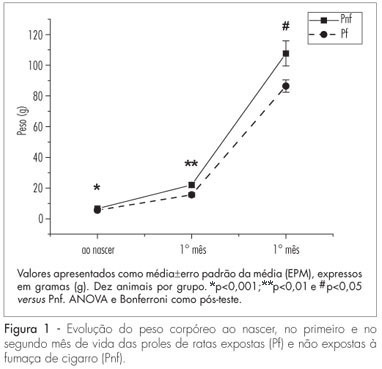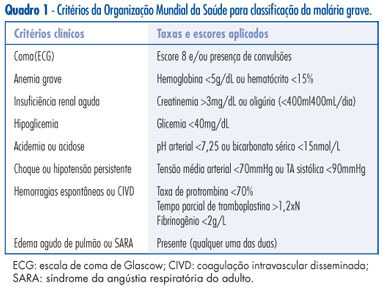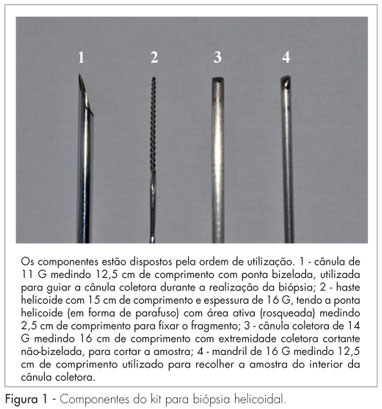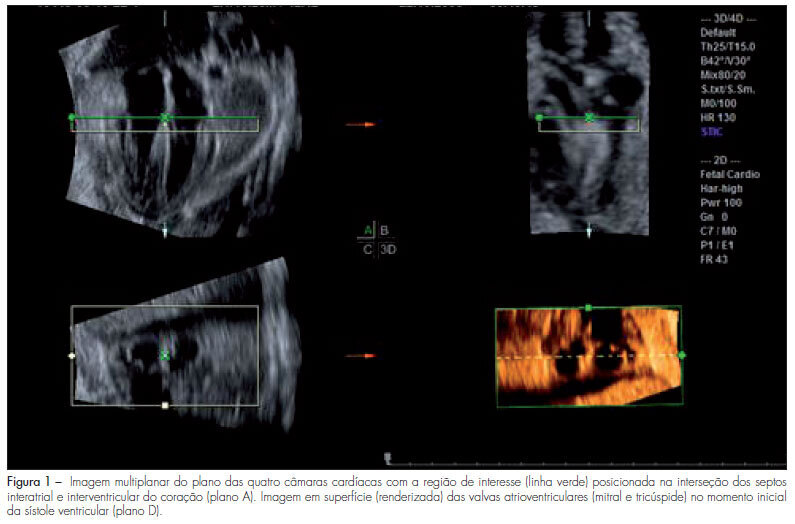Summary
Revista Brasileira de Ginecologia e Obstetrícia. 2011;33(1):27-30
DOI 10.1590/S0100-72032011000100004
PURPOSE: to evaluate the concordance rate of ultrasound-guided core needle biopsy followed by excisional biopsy in palpable breast lumps, suggestive of fibroepithelial tumors. METHOD: a retrospective study included 70 biopsies with a histological diagnosis of fibroepithelial tumor in 67 out of 531 patients with breast lesions submitted to ultrasound-guided core needle biopsy with a high frequency (7.5 MHz) linear transducer, using an automatic Bard-Magnum gun and a 14-gauge needle. Cases with a diagnosis of fibroepithelial tumor by core needle biopsy or excisional biopsy and with a diagnosis of fibrosclerosis were included in the study. The agreement between the two biopsy methods was assessed using the Kappa coefficient. RESULTS: excisional biopsy revealed 40 cases of fibroadenoma (57.1%), 19 cases of phyllodes tumor (27.2%), and 11 cases of fibrosclerosis (15.7%). The concordance rate for fibroadenoma was substantial (k = 0.68, 95%CI = 0.45 - 0.91), almost perfect for the phyllodes tumor (k = 0.81, 95%CI = 0.57 - 1.0), and moderate for fibrosclerosis (k = 0.58, 95%CI = 0.36 - 0.90). CONCLUSIONS: the core needle biopsy is a minimally invasive method that has "substantial" to "almost perfect" concordance rate with excisional biopsy. Fibrosclerosis should be considered in the differential diagnosis of fibroepithelial tumors.
Summary
Revista Brasileira de Ginecologia e Obstetrícia. 2010;32(12):591-596
DOI 10.1590/S0100-72032010001200005
PURPOSE: to investigate the effect of cigarette smoke exposure on body and tissue weight gain, serum parameters and milk yield during pregnancy and lactation in rats, and the impact on offspring from birth toil young adulthood. METHODS: 40 Wistar pregnant rats were randomly divided into: CG - not exposed to cigarette smoke and sacrificed at the end of pregnancy; CL - not exposed to cigarette smoke and sacrificed at the end of lactation; FG - exposed to cigarette smoke and sacrificed at the end of pregnancy; FL - exposed to cigarette smoke and sacrificed at the end of lactation. The offspring were separated by gender and divided according to their mothers' groups. Tissue weight, body weight and serum parameters were evaluated in rats and offspring. Milk yield per pup was calculated. RESULTS: body weight was decreased in FL during lactation (CL=267.0±7.2; FL=235.5±7.2 g*,*p<0.05). Adipose tissue was not detected in the CL and FL groups, and was reduced in FG compared to CG (CG=3.3±0.3; FG=2.4±0.3 g*, *p<0.05). Rats exposed to cigarette smoke had higher blood glucose levels (CG=113±17, CL=86±16, FG=177±21*, FL=178±23 mg/dL*, *p<0.05 CG versus FG e CL versus FL), CL and FL groups presented lower HDL-cholesterol with no change in total cholesterol. Finally, rats exposed to cigarette smoke had lower milk yield compared to unexposed rats (CL=6.7±0.4, FL=5.4±0.3 g*, *p<0.05). In offspring from the FG and FL groups, there was a decrease of body weight from birth to young adulthood, with no changes in gastrocnemius, liver or heart weights in any group, and adipose tissue was no detected in female offspring. There was an increase in blood glucose in offspring of both sexes from rats exposed to cigarette smoke (males: Pcg=107±10.5, Pcl=115±8.6, Pfg=148±16.8*, Pfl=172±11.2**; females: Pcg=109±27.2, Pcl=104±9.7, Pfg=134±20.0*, Pfl=126±13.3**; p<0.05 *Pcg versus Pfg and **Pcl versus Pfl). CONCLUSIONS: exposure to cigarette smoke provokes impairment of morphometric and serum parameters during pregnancy and lactation both in mothers and offspring, which is maintained during young adulthood.

Summary
Revista Brasileira de Ginecologia e Obstetrícia. 2010;32(12):584-590
DOI 10.1590/S0100-72032010001200004
PURPOSE: to evaluate the differences between the maternal and perinatal outcomes of pregnancies complicated by preeclampsia, according to the classification as the severe/mild form, and the early/late onset form. METHODS: a retrospective study with 211 pregnancies complicated by preeclampsia, assessed at a university reference center from 2000 to 2010. The diagnosis and disease severity were based on the values of blood pressure, proteinuria, and clinical and laboratory findings. The pregnant's age, skin color, parity, blood pressure, urine protein semiquantitative values, presence of bilateral notch in the uterine artery dopplervelocimetry and birth conditions were compared between patients with mild and severe disease, as well as between those of early/late onset. The disease was considered to be of early onset when diagnosed at less than 34 weeks of gestational age. RESULTS: most patients had the severe form of preeclampsia (82.8%), and the onset of the condition was early in 50.7%. Blood pressure values (133.6±14.8 versus 115.4 mmHg, p=0.0004 and 132.2±16.5 versus 125.7 mmHg, p=0.0004) and semiquantitative proteinuria (p=0.0003 and p=0.0005) were higher in the early and severe forms compared to mild and late forms. Infant birth weight (1,435.4±521.6 versus 2,710±605.0 g, 1,923.7±807.9 versus 2,415.0±925.0 g, p<0.0001 for both) and Apgar score (p=0.01 for both) were smaller for severe and early preeclampsia compared to mild and late preeclampsia. On the other hand, the presence of a bilateral notch in the uterine arteries was linked to the forms of early onset (69.2 versus 47.9%, p=0.02), whereas fetal growth restriction was more frequent in the severe forms of preeclampsia (30 versus 4.4%, p=0.008). CONCLUSION: the preeclampsia classification based on maternal clinical parameters better reflected the conditions of fetal nutrition, while the early onset of the condition was associated with placental vasculopathy detected by dopplervelocimetry.
Summary
Revista Brasileira de Ginecologia e Obstetrícia. 2010;32(12):579-583
DOI 10.1590/S0100-72032010001200003
PURPOSE: to analyze the clinical course of three pregnant patients with severe malaria admitted to the intensive care unit of a hospital in Porto Velho (RO), Brazil. METHODS: a descriptive study was conducted on three pregnant women infected with Plasmodium falciparum malaria, admitted to the intensive care unit of a hospital in Porto Velho from 2005 to 2006. Categorical variables used were the classification criteria of the World Health Organization which ranks severe malaria and the Acute Physiology and Chronic Health Disease Classification System II (APACHE II) and Sepsis Related Organ Failure Assessment (SOFA) predictors of morbidity and severity of intensive care unit diseases. RESULTS: the malaria acquired by the pregnant subjects characterized by infection with Plasmodium falciparum in its most serious form resulted in death for all three patients and their fetuses. CONCLUSIONS: although the sample of this study was small it reflects the important impact of severe malaria on pregnant women as well as the need for a more judicious and attentive prenatal care to identify the disease in its early stages and its first complications in pregnant women.

Summary
Revista Brasileira de Ginecologia e Obstetrícia. 2010;32(12):602-608
DOI 10.1590/S0100-72032010001200007
PURPOSE: to prospectively evaluate the effects of immediate breast reconstruction on the quality of life of women who underwent mastectomy. METHODS: 76 women that underwent mastectomy at Centro de Atenção Integral à Saúde da Mulher da Universidade Estadual de Campinas, in Campinas, São Paulo, Brazil, from August 2007 to December 2008, were included. Two groups were formed: 41 women who underwent mastectomy combined with immediate breast reconstruction (M+RI) and 35 that were subjected to mastectomy alone (M). The quality of life evaluation was assessed with the World Health Organization's questionnaire - Quality of Life (WHOQOL-100). The questionnaire was administered on three occasions: at the time of admission, one month after surgery, and again six months after surgery. The WHOQOL-100 scores were calculated according to analysis' guidelines by the World Health Organization. For comparison of the scores between groups, it was used the Student's t-test, Fisher exact test, chi-square test, and Mann-Whitney test. For the analysis of repeated measures over time, ANOVA and ANOVA for repeated measures were used. RESULTS: at all time points evaluated, beginning with the preoperative assessment, the average quality of life scores of the M+IR Group were higher than those of the M Group, primarily in the "physical", "psychological", "level of independence" and "social relationships" domains of the questionnaire. Of the six areas covered by the questionnaire, three ("physical", "social relations", "environment") showed no significant differences between groups. The M+IR Group had a better score (15.5 to 14.9 for the M+IR and 14.3 to 14.2 for M; p=0.04) in the psychological domain. There was a significant reduction in the level of independence in the first month after surgery in both groups, with a significant recovery after six months. CONCLUSIONS: the present results suggest that immediate breast reconstruction is significantly beneficial regarding the psychological aspects of quality of life, without affecting the patient's physical functionality.
Summary
Revista Brasileira de Ginecologia e Obstetrícia. 2010;32(12):597-601
DOI 10.1590/S0100-72032010001200006
PURPOSE: to assess the helicoid biopsy performance when carrying out breast biopsies. METHODS: thirty patients with breast cancer submitted to mastectomy were selected at random. Women with a tumor of petreous consistency, nonpalpable, submitted to previous surgical manipulation or containing fluid were excluded. The helicoid biopsy kit and a core biopsy device with a cannula and a 14-gauge-needle, respectively, were used to collect a fragment each from a healthy area and from the tumor of each surgical specimen, for a total of 120 fragments for histological study. Data were analyzed statistically by the parametric Student's t-test and by the Kappa concordance index at the 95% confidence level, using the SPSS software, version 13. RESULTS: the mean patient's age was 51.6 (±11.1) years old. The core biopsy showed 93.3% sensitivity, 100% specificity and 96.7% accuracy, and the helicoid biopsy showed 96.7% sensitivity, 100% specificity, and 98.3% accuracy. The comparison of tumor histology and biopsy fragments revealed a high degree of concordance in the diagnoses (Kappa equal to 0.9, with p<0.05). CONCLUSIONS: both methods provided a highly accurate histological diagnosis of the lesions. The results of the present study demonstrate that the helicoid biopsy is a reliable alternative for the preoperative diagnosis of breast lesions.

Summary
Revista Brasileira de Ginecologia e Obstetrícia. 2010;32(12):573-578
DOI 10.1590/S0100-72032010001200002
PURPOSE: to establish reference values for the length and area of the fetal corpus callosum between the 20th and 33rd weeks of gestation using three-dimensional ultrasound (3DUS). METHODS: this cross-sectional study involved 70 normal pregnancies with gestational age between 20 and 33 weeks. An Accuvix XQ instrument with a convex volumetric transducer (3 to 5 MHz) was used. To assess the corpus callosum, a transfrontal plane was obtained using the metopic suture as an acoustic window. Length was obtained by measuring the distance between the proximal and distal extremities of the corpus callosum. Area was obtained by manual tracing of the external corpus callosum surface. The means, medians, standard deviations, and maximum and minimum values were calculated for the corpus callosum length and area. Scatter graphs were created to analyze the correlation between corpus callosum length and area and gestational age and biparietal diameter, the quality adjustments was verified according to the determination coefficient (R²). The intraclass correlation coefficient (ICC) was used to assess the intraobserver variability. RESULTS: mean corpus callosum length increased from 21.7 (18.6 - 25.2 mm) to 38.7 mm (32.6 - 43.3 mm) between 20 and 33 weeks of pregnancy, respectively. Mean corpus callosum area increased from 55.2 (41.0 - 80.0 mm²) to 142.2 mm² (114.0 - 160.0 mm²), between 20 to 33 weeks of pregnancy, respectively. There was a strong correlation between corpus callosum length and area and gestational age (R² = 0.7 and 0.7, respectively) and biparietal diameter (R² = 0.7 and 0.6, respectively). Intraobserver variability was appropriate, with an ICC of 0.9 and 0.9 for length and area, respectively. CONCLUSIONS: reference values for corpus callosum length and area were established for fetuses between 20 and 33 weeks gestation. Intraobserver variability was appropriate.
Summary
Revista Brasileira de Ginecologia e Obstetrícia. 2010;32(9):426-432
DOI 10.1590/S0100-72032010000900003
PURPOSE: to evaluate the areas of the atrioventricular valves (tricuspid and mitral) of normal fetuses by the use of three-dimensional ultrasound (3DUS) and the spatiotemporal image correlation (STIC) method. METHODS: a cross-sectional study was conducted on 141 women between the 18th and the 33rd week of pregnancy. Cardiac volumes were measured with a volumetric transabdominal transducer attached to the Voluson 730 Expert equipment. The four chamber plane was used as reference, with the region of interest (ROI) positioned from the ventricles, and the area of the valves was obtained manually. To determine the correlation of the areas with gestational age, scatter plots were constructed and the Pearson correlation coefficient (r) was calculated. Means, medians, standard deviations (SD) and maximum and minimum values were calculated. The simple linear regression model was used to determine reference ranges of valve areas according to the gestational age by the Altman method, with the level of significance set at p<0.05. To calculate the intraobserver reproducibility, we used the intraclass correlation coefficient (ICC) and the Bland-Altman graph. RESULTS: the mitral and tricuspid valve areas were correlated to the gestational age (r=0.80 for the tricuspid and r=0.79 for the mitral valve) and the mean value of the tricuspid and mitral valves increased from 0.22±0.10 cm² and 0.23±0.10 cm² on the 18th week to 0.92±0.29 cm² and 1.08±0.41 cm² on the 33rd of pregnancy, respectively. The intraobserver reproducibility resulted in an ICC=0.993 (95%CI 0.987; 0.996) and the mean difference was 0.01 cm² (SD±0.2 cm² and CI95%±0.4 cm²). CONCLUSION: reference intervals for the areas of the mitral and tricuspid valve between the 18th and the 33rd week of gestation were determined and proved to be highly reproducible.
